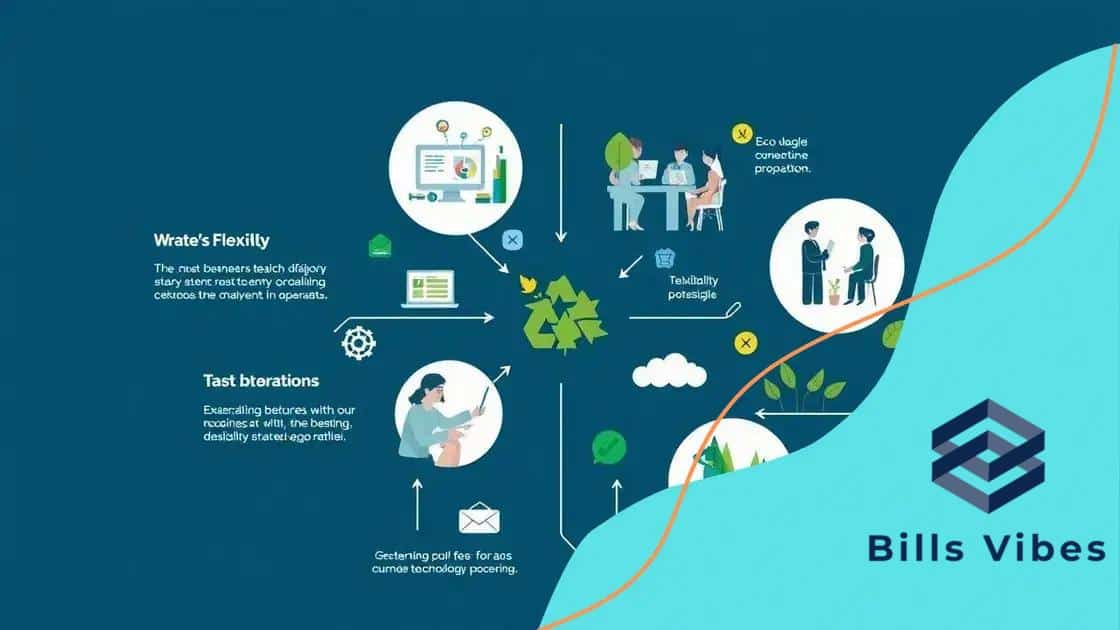Global supply chain shifts: what they mean for businesses

Global supply chain shifts are driven by sustainability demands, technological advancements, economic fluctuations, and changing consumer behaviors, requiring businesses to adapt their strategies for efficiency and resilience.
Global supply chain shifts are reshaping how businesses operate today. Have you noticed how some products seem harder to find? That’s the ripple effect of these ongoing changes. Let’s dive into what they mean for your business.
Understanding global supply chain dynamics
Understanding global supply chain dynamics is essential for businesses today. Supply chains are more interconnected and complex than ever before, influenced by various factors like technology, economics, and geopolitical events.
Key Components of Global Supply Chains
Several vital elements contribute to the dynamics of global supply chains. By recognizing these components, companies can better adapt to changes and enhance their operations:
- Logistics and Transportation: Efficient logistics ensure timely delivery of goods, impacting customer satisfaction.
- Supplier Relationships: Strong relationships with suppliers can lead to better negotiation terms and reliability.
- Market Demand: Understanding shifts in consumer demand helps businesses adjust their inventory and production accordingly.
As businesses navigate these relationships, they often encounter challenges like fluctuations in global trade policies. For instance, tariffs and trade agreements can significantly impact cost structures, forcing companies to reevaluate their sourcing strategies.
The Role of Technology
Technology plays a crucial role in shaping global supply chain dynamics. Innovations such as artificial intelligence and blockchain are transforming how companies manage their operations. AI algorithms can forecast demand more accurately, while blockchain enhances transparency and security.
Companies are increasingly investing in these technologies to gain a competitive edge. By adopting advanced solutions, they can streamline processes, reduce costs, and improve overall efficiency.
In a world subject to rapid change and uncertainty, understanding and adapting to global supply chain dynamics has never been more critical. Developing agility in operations allows businesses to respond effectively to unforeseen disruptions.
Key factors driving supply chain shifts
Several key factors are driving shifts in global supply chains, fundamentally changing how businesses operate. Understanding these factors can help organizations adapt their strategies effectively.
Economic Changes
One primary driver is economic fluctuations. Changes in currency exchange rates, inflation, and economic growth affect costs and supply chain decisions. When economies undergo rapid changes, businesses must adjust their sourcing and distribution strategies accordingly.
- Tariffs and Trade Policies: New tariffs can alter sourcing decisions, pushing companies to find alternative suppliers.
- Global Economic Trends: Shifts towards emerging markets can lead to new opportunities but also bring challenges.
- Supply and Demand Discrepancies: Seasonal demand spikes require businesses to prepare in advance to avoid stockouts.
Another crucial factor involves shifts in consumer behavior. As customers demand faster delivery times and more sustainable products, companies are forced to reassess their supply chain approaches. The rise of e-commerce has dramatically changed consumer expectations, increasing pressure on businesses to innovate.
Technological Advancements
Technology plays a significant role in these shifts. Innovations such as automation, artificial intelligence, and the Internet of Things (IoT) have transformed logistics and warehousing. Businesses now use sophisticated software to predict demand more accurately and manage inventory levels more effectively.
This technological evolution allows for greater efficiency and transparency in supply chains. Using data analytics, companies can track shipments in real-time, providing customers with up-to-date information about their orders.
Additionally, sustainability has become a major concern. As awareness of environmental issues grows, more consumers prefer to support businesses that prioritize ecological responsibility. This change pushes firms to rethink their sourcing materials and logistics practices, striving for greener alternatives.
Strategies for businesses adapting to changes

Businesses today must implement effective strategies for adapting to rapid changes in global supply chains. With the landscape constantly evolving, organizations that can pivot quickly will thrive.
Flexibility in Operations
A key strategy is building flexibility into operations. Companies must be ready to alter their production processes, sourcing, and logistics based on current market demands. By adopting a more agile approach, businesses can respond quickly to disruptions.
- Diversifying Suppliers: Relying on multiple suppliers reduces risk and allows companies to switch sources if needed.
- Local Sourcing: Bringing some production closer to home can minimize delays and reduce transportation costs.
- Adjusting Inventory Levels: Smart inventory management helps meet changing consumer demands without overstocking.
Another essential strategy involves investing in technology. Advanced tools, such as data analytics, can provide insights into supply chain performance. This helps businesses make informed decisions and respond to challenges effectively.
Collaboration and Transparency
Collaboration with partners and suppliers is crucial. Establishing strong relationships fosters communication and enables smooth adjustments to changes. When all parties are aligned, it enhances efficiency and reliability.
Increasing transparency across the supply chain can also enhance trust among stakeholders. Companies that share information about their processes and practices can build stronger relationships and adapt more readily to external changes.
Moreover, adopting sustainable practices is becoming a priority for many organizations. As consumers become more environmentally conscious, businesses that prioritize sustainability may gain a competitive edge. This can include using eco-friendly materials and improving energy efficiency in operations.
Impact of technology on supply chains
The impact of technology on supply chains is transformative. New tools and innovations are reshaping how businesses operate, making processes more efficient and responsive.
Automation and Robotics
One major advancement is automation. Companies are increasingly using robots to handle repetitive tasks. This shift not only increases productivity but also reduces human error. Automated systems can manage inventory and streamline warehouse operations.
- Increased Efficiency: Automation speeds up production, allowing businesses to meet customer demand more effectively.
- Cost Reduction: Fewer errors lead to lower operational costs, improving profit margins.
- Scalability: Automated systems can easily scale to accommodate business growth.
Another critical area is the use of data analytics. Businesses now collect vast amounts of data to understand their supply chains better. By analyzing this data, organizations can gain valuable insights into performance and customer behavior.
Real-Time Tracking
With real-time tracking, companies can monitor shipments from start to finish. This transparency enhances customer satisfaction by providing up-to-date information. Customers appreciate knowing the status of their orders, which builds trust and loyalty.
Moreover, technology enables improved communication between partners in the supply chain. Cloud-based platforms allow for instant sharing of information, making collaboration easier and more efficient. When teams across different locations access the same information, decision-making becomes quicker and more effective.
Lastly, technologies like blockchain are bringing more security to supply chains. With blockchain, transactions can be recorded in a tamper-proof manner, ensuring data integrity. This is essential in preventing fraud and maintaining trust among supply chain partners.
Future trends in global supply chains
Future trends in global supply chains are shaping the way businesses will operate in the coming years. As technology advances and consumer preferences evolve, companies must stay ahead of these trends to remain competitive.
Sustainability in Supply Chains
One significant trend is the increasing focus on sustainability. Companies are now seeking to reduce their environmental impact through eco-friendly practices. This includes using sustainable materials, reducing waste, and implementing energy-efficient processes.
- Green Logistics: Improving transport methods to lower carbon footprints.
- Ethical Sourcing: Ensuring materials come from responsible suppliers.
- Waste Reduction: Minimizing waste through better recycling and reusing practices.
As consumers prefer brands committed to sustainability, businesses will need to adapt their supply chains accordingly to meet this demand.
Advanced Technology Integration
Another major trend is the integration of advanced technologies. The rise of artificial intelligence, machine learning, and the Internet of Things (IoT) are revolutionizing supply chain management. These tools enable more efficient processes and data-driven decision-making.
With AI, companies can forecast demand more accurately, while IoT devices allow for better real-time tracking of inventory and shipments. This results in increased transparency and responsiveness throughout the supply chain.
Additionally, automation will continue to play a significant role in the future of global supply chains. Robotics will automate repetitive tasks, freeing up human resources for more strategic activities. This shift will enhance productivity and reduce operational costs.
Lastly, the ongoing trend towards globalization will require businesses to navigate complex international regulations and trade agreements. Companies that can adapt to these changes will be better positioned to succeed in the global market.
In conclusion, understanding the shifts in global supply chains is essential for businesses aiming to thrive in today’s dynamic marketplace. By embracing sustainability, leveraging advanced technologies, and staying agile, organizations can successfully navigate future challenges. As we look ahead, the integration of these trends will help companies build resilient supply chains that meet evolving consumer demands.
FAQ – Frequently Asked Questions about Global Supply Chains
What are the main factors driving changes in global supply chains?
Key factors include economic fluctuations, consumer behavior changes, technological advancements, and sustainability demands.
How can automation improve supply chain efficiency?
Automation reduces manual tasks, speeds up processes, and minimizes errors, allowing for more efficient operations.
Why is sustainability important in supply chains?
Sustainability is crucial as consumers increasingly prefer eco-friendly brands, and it helps reduce environmental impacts.
What role does technology play in modern supply chains?
Technology enables real-time tracking, better data analysis, and improved communication, enhancing overall supply chain performance.






